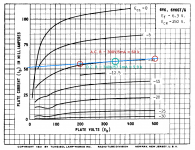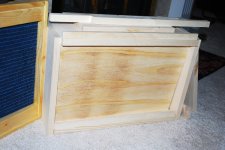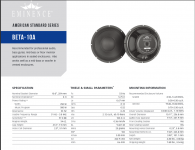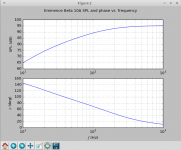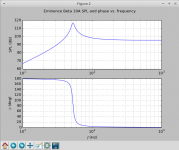There are some ported cabs, the problem is that we stuff a lot of sq in of cone area in a small box. The port becomes rather small to the point where it is ineffective. On IC's not managing the transient, the most used IC in guitardom is of the TL07X variety. It has a slew rate of 13V/uS and with normal amp supply voltages it should stay clean enough to hit the power amp section with more than enough signal to reach full output cleanly. Now if the amp has a volume and a master volume, then you could overdrive the preamp section and as with any amp with NFN, once you clip the output circuitry (IC, power amp, tube amp...) you are now operating the circuit in open gain conditions. Gain goes up but when you are pinned to your supply rail an over gain condition of 3dB, 10dB, 20dB, hardly matters.
How the circuit recovers is of interest. Marshall 18 Watt amps are notorious for having the output stage move into Class B conditions with visible crossover distortion. When I made my low voltage 2W 5E3 I biased up the outputs and then cranked the amp and listened, adjusting the bias to get the best sound. The best bias sonically was where the crossover distortion started to appear. The reason the bias changes is the stage is cathode biased with a capacitor bypass of the AC. During overload the signal is rectified from what I recall and the bias shifts. Is this a good thing or bad thing? A bit of grit can help a guitar cut through, part of the charm of the 18 Watt. The bias also shifts on interstage capacitors when we overdrive the input of the next stage. Maybe it is the much touted 'touch sensitive' effect that a lot of reviewers mention. The amplification in the stage changes depending how much you overdrive the stage. In the power supply it is the sag factor.
I am not sure if you can take the plate resistance of the output tube and scale it through the transformer to get the output impedance. I think of the internal impedance of the tube as being variable. It is greatest at cutoff, it has to otherwise current will flow. On the other end of the scale, with full signal it has to have a low resistance otherwise we would not get our maximum current flow.
How the circuit recovers is of interest. Marshall 18 Watt amps are notorious for having the output stage move into Class B conditions with visible crossover distortion. When I made my low voltage 2W 5E3 I biased up the outputs and then cranked the amp and listened, adjusting the bias to get the best sound. The best bias sonically was where the crossover distortion started to appear. The reason the bias changes is the stage is cathode biased with a capacitor bypass of the AC. During overload the signal is rectified from what I recall and the bias shifts. Is this a good thing or bad thing? A bit of grit can help a guitar cut through, part of the charm of the 18 Watt. The bias also shifts on interstage capacitors when we overdrive the input of the next stage. Maybe it is the much touted 'touch sensitive' effect that a lot of reviewers mention. The amplification in the stage changes depending how much you overdrive the stage. In the power supply it is the sag factor.
I am not sure if you can take the plate resistance of the output tube and scale it through the transformer to get the output impedance. I think of the internal impedance of the tube as being variable. It is greatest at cutoff, it has to otherwise current will flow. On the other end of the scale, with full signal it has to have a low resistance otherwise we would not get our maximum current flow.
....
I am not sure if you can take the plate resistance of the output tube and scale it through the transformer to get the output impedance. I think of the internal impedance of the tube as being variable. It is greatest at cutoff, it has to otherwise current will flow. On the other end of the scale, with full signal it has to have a low resistance otherwise we would not get our maximum current flow.
The tube is non-linear. It can have one "resistance" for DC and another resistance for small swings around that point.
Yes, a naked pentode output Z is often 10X the happy load Z.
As mentioned, NFB changes that. Many Fenders run enough NFB to get Zout near Z load, but some have less NFB and more Zout.
A full understanding of the speaker equations allows you to incorporate Zout into Qe. Now Qe goes from typically 0.7 to more like 7. And indeed, mechanical damping now dominates (so you don't even need any exact number for Zout).
If port size gets "small", it can still function, but it will wheeze. You can go fairly small on soft-speakers. Guitar speakers are played LOUD, and while some kinds of "dirt" may be tolerated, apparently wheezy bass is not a favorite tone.
Venting makes most sense for a small driver in a very big box. Guitar generally favors quite large drivers. And of course portable boxes. And guitar is not deep bass. Open-back functions very well. Sealed competes but open-back stays valid.
I don't think he's playing any practical jokes.I am very impressed by the sound clips KMG posted. Assuming they're legit, and KMG wasn't playing a practical joke on the world, his work seems to be far ahead of anything else I've heard from a solid-state guitar amp, analogue or digital. He even got "gling" out of a handful of LND 150 MOSFETs!
Way back in the day, long before LND150s were available, a trick for adding a gain stage to a tube amp was the jfet-mosfet cascode.
A 2n5485 jfet and an IRF820 mosfet works nicely with the Leo Fender approved 100k/1k5 resistors.
You get about 1.5v on the source of the jfet and about 2/3 v+ on the drain of the mosfet, gain of about 50, pretty close to a 12ax7.
Makes a really good 1st stage, no hum or microphonics, It has the proper "gling" and sounds good overdriven with a booster pedal.
I've used that cascode for regular gain stages, reverb driver, reverb recovery, and tremolo oscillator.
Here is the general circuit that I have used:
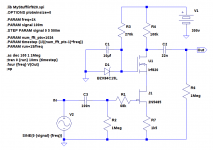
Signal step, into heavy overdrive:
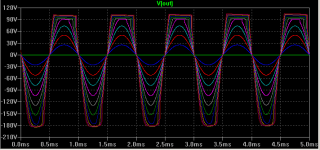
Now, that cascode circuit makes no attempt to mimic a 12ax7, if anything, it mimics a pentode such as EF86. No attempt at simulating grid current either. So what. If it sounds right, I'm good with it.
I haven't played with LND150s, but I suspect you could get a good sound out of them even without the elaborate KMG schottky diodes and negative supply.
If you want to simulate grid current, the simple way is a silicon diode pointing from gate to ground. You can tune it by playing with the series resistor from input to gate, 68k, 100k, 220k, 470k, all the common values used by Leo and Jim (Marshall).
I imagine that gets you 90% "there", and KMG was going for 100%, thus all the schottkys and negative supply.
The problem with high voltage is, I get a little nervous interfacing high voltage stuff to low voltage stuff.
The main worry is the power on spike, which can wreak havoc with low voltage stuff downstream.
KMG uses a voltage divider on the output, maybe that's adequate.
There is an unfortunate relationship between deep bass, small cabs, and loudspeaker efficiency. You can get deep bass in a small ported cab, but efficiency drops like a rock. (Because you have to make the moving parts of the speaker heavy to get that deep bass in the small cab, and, as you say, make the speaker cone area smaller too.)There are some ported cabs, the problem is that we stuff a lot of sq in of cone area in a small box.
I agree, plenty of slew rate, but maybe not enough headroom, given that the huge initial attack transient may be 10 dB - 20 dB bigger than the rest of the signal. So you may get brief harsh clipping at the beginning of each note.On IC's not managing the transient, the most used IC in guitardom is of the TL07X variety.
If you do design for low opamp stage gain, the transient is faithfully reproduced - and that too sounds harsh and painful.
MJD_Tech and I both hypothesize that electric guitars sound better if that huge initial transient is substantially squished, which valves seem to do naturally. With opamps, there seems to be no way to win - either you get harsh transient clipping, or perfect reproduction, which also sounds harsh.
I think this is exactly the thing that smooths out that big initial attack transient - gain drops like crazy for such a big signal.The amplification in the stage changes depending how much you overdrive the stage.
Tinkering with pentode / beam tetrodes in the preamp, I found you can easily get very audible amounts of this sort of transient "squishing". Because small-signal pentodes usually use a large-value resistor to bias the screen grid, "sag" can be tremendous - small changes in screen grid current can drastically lower the screen grid voltage because of the big screen resistor.
One of the guys at a jam once asked me if I was using a slap-back echo. I wasn't, it was the beam-tetrode "squishing" the initial note attack, and recovering a split second later (screen grid bypass cap charging back up), making the note dip and swell again, just like an echo pedal.
Agreed that anode resistance is definitely variable, so this is very much an approximate calculation. But I think it's a reasonable "guesstimate". Perhaps +/- 30% or so (i.e. within one order of magnitude)?I am not sure if you can take the plate resistance of the output tube and scale it through the transformer to get the output impedance. I think of the internal impedance of the tube as being variable.
Current sources are magic - a mathematically ideal one amp current source with one volt across it has a DC resistance of one ohm, but an AC resistance of infinity!On the other end of the scale, with full signal it has to have a low resistance otherwise we would not get our maximum current flow.
More realistically, take a look at the attached Tung Sol 6V6 datasheet curves. I picked a reasonable operating point, and at that point, DC resistance is around 6 kilo ohms, while AC resistance is around 60 kilo ohms, ten times higher!
Some "big bottle" output valves have much lower anode resistance. I think I saw 15 kilo ohms on a data sheet recently, for an EL 34 or 6L6 or something similar.
But four times lower than 50 ohms is still 12 ohms - still much more than the nominal 8 ohm impedance of the guitar speaker.
For me, that was the surprise - that the typical valve guitar amp has enough output resistance to kill most of the electromagnetic damping from speaker voice coil back EMF.
Which means, enough output resistance to cause a huge undamped bass hump in the frequency response.
I think that's why we don't see Thiele-Small parameters for guitar speakers, but do see them for bass guitar speakers which are usually driven by solid-state amps.
Incidentally, things change drastically when you look at "ultra-linear" pentode output stages. All that negative feedback to the screen grid turns those pentodes into something that behaves more like a triode than a pentode as far as anode resistance goes - it drops by a very substantial factor.
Looking at a few data sheets, I estimated four to ten fold, depending on the screen-grid to cathode gm of the valve. I think the 80k 6V6 anode resistance drops to something like 8k in pure triode mode. It should be somewhere in between 80 and 8 for ultra-linear mode.
That's probably not very relevant to guitar amps, though maybe for a few valve bass guitar amps.
-Gnobuddy
Attachments
Agreed, except when manufacturers try to scale down the open-back cab to make their small solid-state guitar amps resemble their big "classic" valve amps....guitar is not deep bass. Open-back functions very well.
Those small cabs don't have the same relationship to the wavelengths of guitar sounds, so bass suffers terribly, and all the internal standing-wave resonances move up into the frequency range where the human ear finds them sounding very "boxy". They wouldn't sound quite so boxy-nasty if the manufacturers stuffed the box with acoustic damping insulation, but it's hard to do that with an open cab!
I think ye olde Princeton Reverb cab is about as small an open-back guitar cab as you can have without starting to sound bad.
-Gnobuddy
...and much less thermal noise than a valve. Having a hot cathode at 1200 Kelvin is a distinct disadvantage when it comes to thermal noise!Makes a really good 1st stage, no hum or microphonics
This is one thing I haven't got out of any kind of FET yet. Less nasty than BJTs, sure. Gling? Nope! (At least, not yet.)It has the proper "gling"
Those are some pretty sharp corners on the positive half-cycles (near +90V on the graph). Usually, corners that square sound very harsh to me. To you?Signal step, into heavy overdrive:
View attachment 648999
My limited experience is: "less bad" than BJTs, but no better than okay sound.I haven't played with LND150s, but I suspect you could get a good sound out of them even without the elaborate KMG schottky diodes and negative supply.
KMG seems to have focused a lot on the overdriven characteristics of 12AX7s - not the "three-halves" curve, but what happens when you push beyond that. And, judging by the sound-clips he posted, it seems to have paid off, big-time!
I'm going to disappear from this forum for a while, got to go down to the wood shop and make some sawdust!
-Gnobuddy
I have seen another 2n5485 / IRF820circuit that I have always been interested in trying. Good to know it sounds ok.
On amp outputs acting as current sources and impedance, voltages. Run the amp open circuit and then with a minimal load (say 100 ohms). You will find the voltage does not vary that much, even non-NFB amps.
On Opamps and their lack of chopping off the peaks or their overloading when they do. Scope it. Otherwise the theories are just talk. Seems their is a new found fondness for SS amps that use these IC's where in days past they were slagged. Fender amps such as the Frontman series (one example) are said to have very good cleans, and a distortion channel that sucks. Most often the culprit of the harsh sound was the cheap speaker. The most common mod for the Frontman 25R is to drop in a Rajin Cajun.
On amp outputs acting as current sources and impedance, voltages. Run the amp open circuit and then with a minimal load (say 100 ohms). You will find the voltage does not vary that much, even non-NFB amps.
On Opamps and their lack of chopping off the peaks or their overloading when they do. Scope it. Otherwise the theories are just talk. Seems their is a new found fondness for SS amps that use these IC's where in days past they were slagged. Fender amps such as the Frontman series (one example) are said to have very good cleans, and a distortion channel that sucks. Most often the culprit of the harsh sound was the cheap speaker. The most common mod for the Frontman 25R is to drop in a Rajin Cajun.
In practice the clipping is a bit smoother.Those are some pretty sharp corners on the positive half-cycles (near +90V on the graph). Usually, corners that square sound very harsh to me. To you?
It's not intended for heavy overdrive like I showed in the simulation, but makes a good clean boost and a bit of nice grit when mildly overdriven.
I have thought of doing this, but have been nervous to try it with any of my valve guitar amps, in case I damage them. I no longer have the income to replace any amps I blow up.On amp outputs acting as current sources and impedance, voltages. Run the amp open circuit and then with a minimal load (say 100 ohms).
It would probably simpler to try one with first 16 ohms, then 4 ohms, and back-calculate. Hopefully that is not far enough off-spec to cause the amp to die.
True enough, as far as proving it (or failing to prove it) to the rest of the world. But there is *something* that causes that increased harshness in virtually all solid-state guitar amps.On Opamps and their lack oScope it. Otherwise the theories are just talk.
I don't get sucked into audiophool fashions - I have used chip amps (both preamp and power amp types) for Hi-Fi since they first became available to me, starting with the venerable (and awful-for-audio) uA741 op-amp. As far as I'm concerned, when the TI TL07x and Signetics NE 5532/5534 arrived, they were essentially perfect for audio - Hi-Fi audio, that is.Seems their is a new found fondness for SS amps that use these IC's where in days past they were slagged.
But then I started to play electric guitar, and found out something very disturbing. Every guitar amp I built or bought that used op-amps sounded harsh and quite horrid. This went on for far too many years, until, in desperation, I tried my first valve guitar amp. And found, to my shock, that my electric guitars now sounded good.
Since the TL072/74, NE 5532, etc are capable of essentially perfect audio reproduction (all distortions below audibility), the harshness I hear is not the fault of the amps.
So it has to come down to the fact that a perfectly amplified solid-body electric guitar sounds absolutely horrid. (To me, anyway, and, apparently, to quite a lot of other guitarists, too. Very few like the sound of a solid-body plugged straight into a high-Z input on a solid-state P.A. system.)
Exactly why an accurately reproduced solid-body electric guitar sounds awful, I do not know for sure, though I have a few likely suspects. But I do know that adding low-order harmonic distortion to the amplifier helps, and so does squishing those initial transients.
Like Kiviak (fermented little auks rotting in a sealskin bag, feathers, feet, intestinal contents and all), Lutefisk, and blood-pudding, there is no accounting for tastes.Fender amps such as the Frontman series (one example) are said to have very good cleans
I have seen this claim about the Frontman amps on the Internet, and I can only assume the people who say this have an entirely different type of hearing mechanism than mine.
I speak from actual experience - I once bought a Frontman 25R for $75, because it was a bright red Christmas special edition, and Guitar Center could not get colour-conservative North American men to buy a bright red guitar amp. The original plan was to gut it and use the chassis, cab, and speaker in a DIY valve guitar amp build.
That never happened because of a family emergency that put most of my plans on hold for quite a while. But I did plug a few of my electric guitars into the Frontman out of curiosity.
To me, the cleans were thin, cold, steely, harsh, and entirely unpleasant. If a cruel fate decreed that it was the last guitar amp on earth, I would pile my electric guitars in a corner and go all-acoustic, rather than be forced to hear the sound of an electric guitar through a Frontman 25R. Not exaggerating, it was pain rather than pleasure for me. (But I'd still rather be forced to play through a Frontman than eat Kiviak.)
I also once bought a larger and more powerful Fender SS amp off Craigslist, because I wanted it's cab and 12" Eminence to pop the guts of my Superchamp XD into. Once again, I tried the SS amp for giggles, and hated it - it actually caused me physical pain, the proverbial needles stabbing your eardrums feeling. I have forgotten the model name, but I think it was rated at 60W and had some on-board DSP sound effects. It might have had "Princeton" in its model name, not sure.
Yes, it has that too. Just like the clean channel.and a distortion channel that sucks.
I tried the Frontman 25R through the stock Eminence speaker in my Superchamp XD - it sounded harsh and awful.Most often the culprit of the harsh sound was the cheap speaker.
I tried the Frontman through the Eminence in my Princeton Reverb - it sounded awful.
I tried running the Superchamp into the Frontman speaker - it sounded good, a little muffled, as long as you didn't turn up too loud.
I tried running the Princeton Reverb into the Frontman speaker - same result, sounded good but slightly muffled at low volume, buzzed if turned up.
But the most effective mod for a Frontman 25R is to drop it into an active volcano. That way, you never have to hear it again.The most common mod for the Frontman 25R is to drop in a Rajin Cajun.
I am kidding around just a little - but not when I say that the worst-sounding guitar amps I've ever heard are all ones that use an accurate, precise, solid-state preamp, followed by an accurate, precise, solid-state power amp.
The Superchamp XD shows that a squishy and inaccurate tube power amp can take away a lot of the harshness from an accurate SS preamp.
The Vox MV50 series shows that a squishy and inaccurate tube preamp followed by an accurate SS power amp doesn't have to sound harsh.
But when both pre and power stages are precise and accurate SS designs - yikes!
All the usual caveats apply - I can only speak for my preferences, your mileage may vary, and you may like the taste of rotting little-auks in a sealskin bag, who knows.
-Gnobuddy
I got most of the wood for the new cab cut, except for the speaker baffle. The material is 1" thick pine block-board to keep the weight down. As usual, 1" actually means 0.75".
Big Brother to the left is a cab I made earlier this year, about the size of a Princeton Reverb cab. That one is made from a piece of furniture IKEA calls a "RAST" nightstand, and currently has two 8" speakers mounted in it.
-Gnobuddy
Big Brother to the left is a cab I made earlier this year, about the size of a Princeton Reverb cab. That one is made from a piece of furniture IKEA calls a "RAST" nightstand, and currently has two 8" speakers mounted in it.
-Gnobuddy
Attachments
Good to know, thanks!In practice the clipping is a bit smoother.
It's not intended for heavy overdrive like I showed in the simulation, but makes a good clean boost and a bit of nice grit when mildly overdriven.
-Gnobuddy
Your results (for output impedance) were much lower than my theoretical estimate?You might be surprised by the result.
-Gnobuddy
Heresy! The cork-sniffing audiophiles will be out to get you now! You just gotta have those $10 opamps and $20 paper in oil caps.I don't get sucked into audiophool fashions - I have used chip amps (both preamp and power amp types) for Hi-Fi since they first became available to me, starting with the venerable (and awful-for-audio) uA741 op-amp. As far as I'm concerned, when the TI TL07x and Signetics NE 5532/5534 arrived, they were essentially perfect for audio - Hi-Fi audio, that is.
LOLBut the most effective mod for a Frontman 25R is to drop it into an active volcano. That way, you never have to hear it again.
I went on youtube to hear a frontman 25r example. I didn't like it very much.
The clean was too clean, thin and sterile.
The distortion was absolutely horrible.
I got the schematic. Typical TL072 affair.
The distortion channel is a combination of Rat and Tube Screamer style diode clipping.
Fender managed to capture the worst traits of both.
There's a fairly interesting tone control circuit, then the usual power amp chip.
Actually the clean channel might be ok with a big hollowbody playing jazz.
OK I'm wrong. I must have had a higher value parallel resistor across the output when trying this before, I used to put them in in case the speaker gets unplugged whale the amp is being driven.Your results (for output impedance) were much lower than my theoretical estimate?
-Gnobuddy
I checked two amps, one single ended with a 6K6 and a P-P with a pair of 12AB5's. Signal was a 400 Hz sine wave.The SE amp gave 0.5V with an 8 ohm speaker and 3.70V with it unplugged. On the P-P I went for 1.0V with speaker and without the voltage went up to 6.03. Interesting that both amps went up by six times.
Now I have to get back to finding my cordless drill. It was driving me nuts looking for it and I decided to do this little test to recompose myself a little, and to allow the drill to come out from where it is hiding.
These one's are not too bad for 25R cleans.
YouTube
YouTube
YouTube
Last edited:
Thanks for doing the tests! That calculates out to around 50 ohms output impedance for the SE amp, and around 40 ohms for the push-pull one.The SE amp gave 0.5V with an 8 ohm speaker and 3.70V with it unplugged.
<snip>
On the P-P I went for 1.0V with speaker and without the voltage went up to 6.03.
Coincidentally, given how inexact my method of estimation was, fifty ohms is actually exactly the number I came up with for a push-pull 6V6 amp - but I was assuming 10 dB of global negative feedback, otherwise it would have been 160 ohms. Dunno if your 12AB5 PP amp has global NFB or not?
But, even if 160 ohms turns out to be 300% too high, the bottom line is that both numbers you measured are much greater than the typical DC resistance of an 8 ohm guitar speaker, meaning that there will be negligible electromagnetic damping, and speaker Q will rise to about Qms at the fundamental resonance. Which makes a huge, huge difference to the bass response.
As it happens, I recently spent a couple of hours working on a mathematical model for loudspeakers, and then writing some Python code to see if my equations looked like they were correct. So, for giggles, I found Thiele-Small data for an Eminence Beta 10A, and ran it through my software, first with an amp with virtually zero source impedance (solid-state), then with a 50 ohm source impedance (and the same amount of drive current to the voice coil). No speaker enclosure was used in either simulation, just the driver in free air.
The results are quite striking if you've never seen them before. Driven the way it was designed to be driven, from a nearly zero source impedance, the Beta 10A driver by itself has very overdamped bass indeed, so there is heavy bass roll-off below 200 Hz (which is already 3 dB down). This driver is not intended to be used this way - stuffing it into a properly sized cab will bring the deep bass up and flatten the response, as the designers intended.
But if you put 50 ohms in series (the equivalent of driving it from Printer2's PP 12AB5 amp), all the speaker designer's hard work goes out of the window. Q rises to about 8 (!), more like a wah-wah pedal than a speaker, and instead of extremely overdamped bass, you get the opposite, an absolutely horrid frequency response, with a huge peak of more than 15 dB, right at the 53 Hz fundamental resonance of the driver.
The Beta 10A is a bass guitar/ P.A. speaker, which is why Eminence publishes Thiele-Small data for it - they're expecting you to drive it with a solid-state amp, and install it in a proper sealed or ported enclosure.
I would love to see the same kind of simulated results (or, even better, actual acoustic measurements) for an actual guitar speaker. But I haven't had luck finding published Thiele-Small data for one.
I think we now know why, TS parameters would be worthless anyway, if you used a valve guitar amp to drive the speaker!
Good luck!Now I have to get back to finding my cordless drill. It was driving me nuts looking for it
Not having a great day here either, I had to visit the medical clinic yesterday to get a prescription for a routine medication refill. The clinic, of course, was full of sick people. And as usual, I feel sick the day after I go anywhere near a clinic. So I've been dragging my tail all day today.
I spent a couple of hours looking for router bits (to make loudspeaker cutouts in the cab I'm building), but never found the ones I was looking for. I did find a roundover bit, which will come in useful soon.
I also found out that I'm going to have to make my own jig if I want to cut circles with my little hand-held router. It came with a jig that will let you cut circles - but not of the proper radius for the drivers I happen to be using. Murphy's law again.
-Gnobuddy
Attachments
If the rest of this thread hasn't already done that.Heresy! The cork-sniffing audiophiles will be out to get you now!
It was okay with my Yamaha electro-acoustic plugged in (that guitar has the now-usual undersaddle piezo and onboard preamp).Actually the clean channel might be ok with a big hollowbody playing jazz.
It was also okay, surprisingly enough, as a bass guitar amp at very low volume, just about loud enough to fatten up the sound of a single unamplified acoustic guitar. With no output transformer, there is usable bass response down to the low E on a 4-string bass. I was surprised, given the tiny open-back cab.
Actually I wish I had that red Frontman 25R back - for the bright-red cab, chassis, Fender knobs, and whatever other guts I could scrounge and re-use in a small valve guitar amp build. I liked that bright Christmas-red cab!
-Gnobuddy
I found one:I would love to see the same kind of simulated results (or, even better, actual acoustic measurements) for an actual guitar speaker. But I haven't had luck finding published Thiele-Small data for one.
http://www.eminence.com/pdf/EGTR_S1012.pdf
Hope you feel better, Gnobuddy.And as usual, I feel sick the day after I go anywhere near a clinic. So I've been dragging my tail all day today.
I just use a jigsaw followed by bit of sanding. I use the router mainly for the roundover bit.I also found out that I'm going to have to make my own jig if I want to cut circles with my little hand-held router.
Here's an article about how valve amps act like current sources and solid state amps act like voltage sources, and how that interacts with the speaker's varying impedance vs. frequency:
http://education.lenardaudio.com/en/12_amps_8.html
Solid state guitar amp manufacturers seem to have recognized the current source vs voltage source thing and incorporated some current drive in their output stages.
The Frontman 25R for example, has this, in the schematic R62, R63, C34.
Marshall valvestate amps have this. Seems to be pretty standard.
I guess it helps some.
I've always just used guitar speakers for guitar, but noticed they are getting to be stupidly expensive these days. I haven't needed to buy a guitar speaker in probably 15 years.
I can see why you are putting so much effort into these boombox speakers.
I wonder if there's anything different with class D amps. I don't know much about them. Some of the audiophile guys say class D has a triode-like presentation, or something.
I do have a cheap "Lepai" class D amp from Parts Express, connected to a TV, driving some cheap bookshelf speakers, also from Parts Express.
It sounds good enough to me, it was cheap, takes up little space, uses little electricity, throws off no heat, gets the job done.
But, I'm not exactly sitting down with a glass of chardonnay, critiquing the "strident timbre of the oboe" in the Royal Philharmonic Orchestra.
Found my drill.
Part of the reason amps like the 5E3 Fender Deluxe, Princeton, sound good at medium volumes (distorted but acceptable) but have the complaint that the speaker flubs out at high volumes is due to the low dampening factor. People select speakers with a tighter bottom end (stiffer suspension) to limit the flubbiness. The rising impedance of the speaker also meant that a tube amp will try to put more power into a speaker at these frequencies than a SS amp will. This unintended EQ may help to give the speaker some 'sparkle' or at times it is called 'ice pick' depending on the player and the amp. So some combinations of amp-speakers work and some don't. Is it a bad amp or speaker? More like they do not react well given the output impedance characteristic of the amp.
Part of the reason amps like the 5E3 Fender Deluxe, Princeton, sound good at medium volumes (distorted but acceptable) but have the complaint that the speaker flubs out at high volumes is due to the low dampening factor. People select speakers with a tighter bottom end (stiffer suspension) to limit the flubbiness. The rising impedance of the speaker also meant that a tube amp will try to put more power into a speaker at these frequencies than a SS amp will. This unintended EQ may help to give the speaker some 'sparkle' or at times it is called 'ice pick' depending on the player and the amp. So some combinations of amp-speakers work and some don't. Is it a bad amp or speaker? More like they do not react well given the output impedance characteristic of the amp.
Yep, the 5E3 has no global negative feedback, so that speaker flaps in the breeze.Part of the reason amps like the 5E3 Fender Deluxe, Princeton, sound good at medium volumes (distorted but acceptable) but have the complaint that the speaker flubs out at high volumes is due to the low dampening factor.
You are totally at the mercy of the speaker characteristics.
I don't think Leo was worrying about that too much at the time.
"Stick the cheapest Jensen in there that won't blow during the warranty period"
The flubs can be tamed by reducing the coupling caps off the phase inverter from 0.1uf to 0.022uf. The Vox AC15 used 0.01. Also, if needed, reduce the cathode bypass cap in the first preamp stage.
Truth be told, I prefer the Blackface era Deluxe to the tweed.
Like many amp enthusiasts, I've built a 5E3 clone. This was about 25 years ago.
I didn't like the preamp. There's supposed to be some "magic" in the way you set the controls or something, but it just didn't work for me.
So I didn't keep the 5E3 circuit, though I still have the amp.
- Status
- This old topic is closed. If you want to reopen this topic, contact a moderator using the "Report Post" button.
- Home
- Live Sound
- Instruments and Amps
- Tube Emulation & EQ
